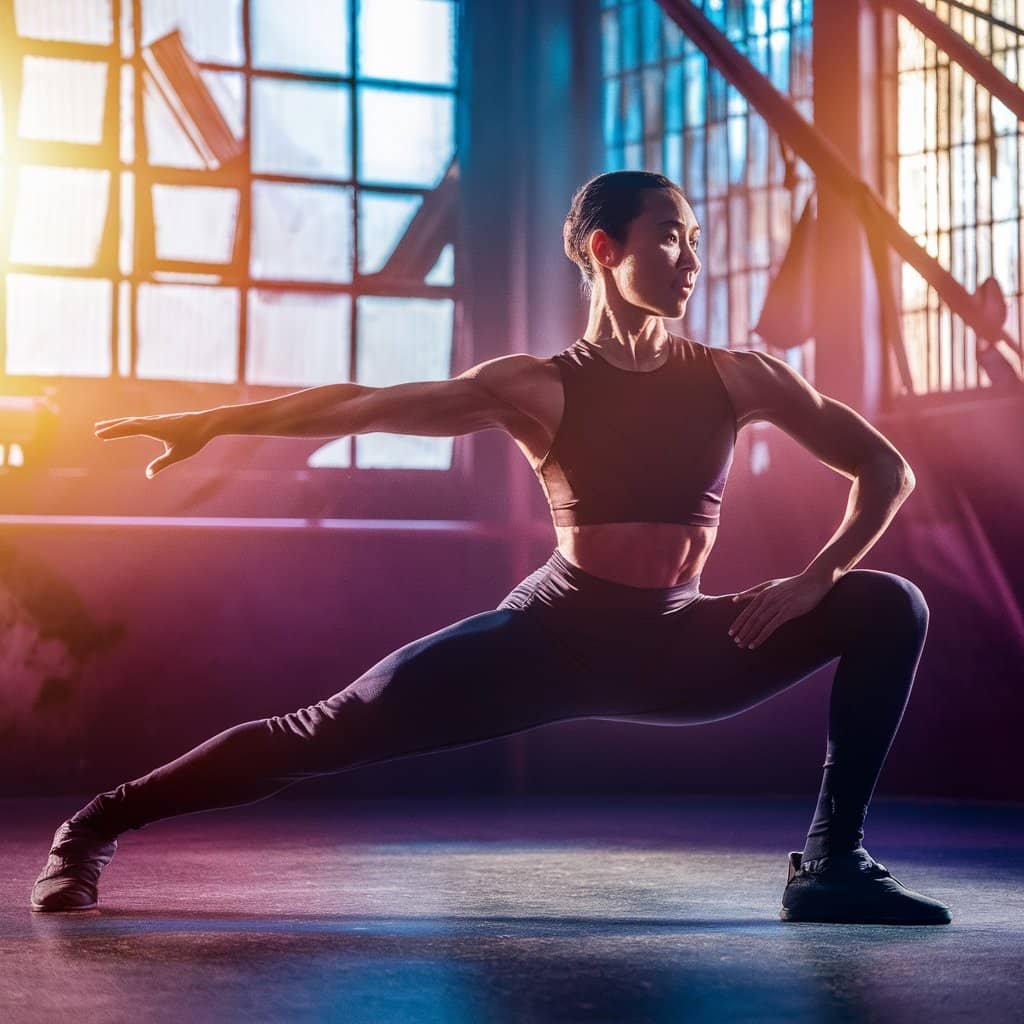Introduction to Side Lunges
Side lunges, also known as lateral lunges, are a versatile and effective exercise that can be easily integrated into home workouts. These movements are particularly beneficial due to their capacity to improve balance, enhance flexibility, and strengthen the lower body muscles. Unlike some other exercises that may require specialized equipment, side lunges can be performed with no equipment at all, making them accessible to everyone.
One of the primary advantages of side lunges is their focus on multiple muscle groups. The glutes, quads, and inner thighs are all engaged during the exercise, leading to stronger and more toned muscles. This comprehensive engagement ensures that side lunges can contribute significantly to overall lower body strength. Furthermore, the lateral movement inherent in side lunges helps to improve lateral stability and coordination, which are often undertrained in traditional forward and backward movements.
Flexibility is another key benefit of incorporating side lunges into your routine. By stretching the inner thighs and groin, this exercise promotes greater range of motion in the hips, which can be particularly beneficial for individuals who spend long hours sitting. Improved flexibility not only enhances performance in physical activities but also reduces the risk of injuries.
Balance is a crucial aspect of physical fitness, and side lunges are excellent for developing this skill. The unilateral nature of the movement requires the body to stabilize itself on one leg at a time, thereby enhancing overall balance and coordination. This can be especially beneficial for athletes or individuals looking to improve their functional fitness.
In summary, side lunges are an effective, equipment-free exercise that offers numerous benefits, including improved balance, enhanced flexibility, and strengthened lower body muscles. Their simplicity and accessibility make them an excellent choice for home workouts, suitable for individuals of all fitness levels.
Classic Side Lunge
The classic side lunge is a fundamental exercise that targets multiple muscle groups, including the glutes, quads, hamstrings, and inner thighs. It’s an excellent addition to any home workout routine, especially for those seeking to build lower body strength without equipment. To perform a classic side lunge correctly, follow these detailed steps:
Begin by standing tall with your feet hip-width apart and your hands on your hips or clasped in front of your chest for balance. Initiate the movement by taking a large step to the right with your right foot. As you step out, ensure that your left foot remains firmly planted, and your toes are pointing forward.
Bend your right knee and push your hips back as if you are sitting into a chair, lowering your body until your right thigh is parallel to the floor. Your left leg should remain straight throughout the movement. Keep your core engaged and your back straight to maintain proper posture. Your chest should be lifted and your gaze forward to prevent rounding of the shoulders.
Push off with your right foot to return to the starting position, ensuring that you engage your glutes and inner thighs during the lift. Repeat the movement on the left side to complete one full repetition. Aim for 10-15 repetitions on each side for a complete set.
Proper foot placement and posture are crucial in executing a side lunge safely and effectively. Common mistakes to avoid include allowing the knee to extend past the toes, not engaging the core, and rounding the back. These errors can lead to unnecessary strain on joints and reduce the effectiveness of the exercise.
It is essential to warm up before starting the classic side lunge, or any exercise, to prepare your muscles and joints for the workout. A dynamic warm-up, including light cardio and dynamic stretches, can help increase blood flow and reduce the risk of injury.
By adhering to these guidelines, you can ensure that your classic side lunge is performed correctly, maximizing the benefits and minimizing the risk of injury.
Curtsy Lunge
The curtsy lunge is a dynamic variation of the side lunge that effectively targets the glutes, inner thighs, and quads. This exercise not only enhances lower body strength but also improves balance and coordination. Here’s how to perform a curtsy lunge correctly:
Begin by standing tall with your feet hip-width apart and your hands placed on your hips for balance. Initiate the movement by stepping your right foot diagonally behind your left leg, as if you were performing a curtsy. As you cross your right leg behind, bend both knees to lower your body into a lunge position. Ensure your front knee is aligned with your ankle and does not extend past your toes. Your back knee should hover just above the ground.
To return to the starting position, press through your left heel and bring your right leg back to the starting stance. Repeat the movement on the opposite side by stepping your left foot diagonally behind your right leg. Continue alternating sides for the desired number of repetitions.
While performing the curtsy lunge, focus on engaging your core to maintain stability. Keep your chest lifted and your shoulders back throughout the movement. This ensures that the primary muscles being worked—the glutes and inner thighs—are activated effectively. Additionally, avoid leaning forward or letting your front knee collapse inward, as this can lead to improper form and potential injury.
For an added challenge, you can hold a pair of dumbbells at your sides or perform the exercise at a slower tempo to increase muscle engagement. The curtsy lunge is a versatile addition to any home workout, requiring no equipment and offering significant benefits in terms of strength and stability.
Lateral Lunge with Reach
The lateral lunge with reach is a dynamic exercise that combines the traditional side lunge with an added upper body movement to enhance core engagement and flexibility. This exercise is ideal for those looking to incorporate a comprehensive, equipment-free workout into their home fitness routine.
To perform the lateral lunge with reach, start by standing upright with your feet shoulder-width apart and your hands resting on your hips. Initiate the movement by taking a large step to the right with your right foot, ensuring your left foot remains stationary. As you step out, lower your body by bending your right knee while keeping your left leg straight. Your hips should push back, and your torso should lean slightly forward to maintain balance.
At the bottom of the lunge, extend your left arm and reach towards your right foot. This reaching motion should be controlled and deliberate, ensuring your back remains straight and your chest is lifted. The key is to engage your core muscles to support your balance and stability throughout the movement.
After completing the reach, push off with your right foot to return to the starting position. Repeat the movement on the opposite side by stepping out with your left foot and reaching towards it with your right arm. Continue alternating sides, ensuring each lunge is performed with precision and control.
Incorporating the lateral lunge with reach into your workout routine offers several benefits. The exercise not only targets the muscles in your lower body, such as the quads, hamstrings, and glutes, but also engages your core, improving overall stability. Additionally, the reaching motion enhances flexibility in your torso and shoulders, promoting better functional movement patterns.
Proper form is crucial to maximizing the effectiveness of this exercise and preventing injury. Always maintain a neutral spine, keep your movements controlled, and focus on engaging your core throughout the lunge and reach. By doing so, you can ensure a safe and effective workout that enhances both strength and flexibility.
Side Lunge to Knee Drive
The Side Lunge to Knee Drive introduces a dynamic twist to the traditional side lunge, offering enhanced cardiovascular benefits and improved coordination and core strength. This exercise combines lateral movement with an explosive upward motion, making it an excellent addition to any home workout routine.
To perform the Side Lunge to Knee Drive, begin by standing with your feet hip-width apart. Engage your core and take a wide step to the right, bending your right knee while keeping your left leg straight. Lower your body into a side lunge, ensuring your right knee does not extend past your toes and your left foot remains flat on the ground. Your torso should be slightly forward, maintaining a neutral spine. Your hands can be clasped together in front of your chest for balance.
From this position, push off your right foot to return to the starting position. As you rise, drive your right knee up towards your chest in a controlled motion. Maintain your balance and engage your core to stabilize your body. Once your right knee reaches its highest point, lower it back down and return to the initial stance. Repeat the movement on the left side, taking a wide step to the left, bending the left knee, and driving the left knee towards the chest. Continue alternating sides for the desired number of repetitions.
Incorporating the knee drive adds a cardiovascular element to the exercise, increasing your heart rate and promoting cardiovascular health. The explosive nature of the knee drive also engages the hip flexors and core muscles, contributing to improved core strength and stability. Furthermore, the coordination required to transition smoothly between the side lunge and knee drive enhances your overall motor skills.
This versatile exercise can be modified to match your fitness level. Beginners may opt to perform the side lunge without the knee drive initially, gradually incorporating the knee drive as they build strength and confidence. Advanced practitioners can increase the intensity by adding a jump as they drive the knee upward, further challenging their cardiovascular endurance and power.
Side Lunge with Pulse
The Side Lunge with Pulse is an excellent variation that targets lower body muscles while enhancing endurance. This exercise involves holding the lunge position and performing small, controlled pulses to intensify the workout. To execute this move correctly, begin by standing with your feet hip-width apart. Initiate the lunge by stepping out to the side with your right foot, keeping your left leg straight. Lower your body by bending your right knee, ensuring that your knee does not extend past your toes. Your weight should be centered over your right heel, and your chest should stay upright.
Once you are in the side lunge position, hold it and start performing small, controlled pulses. This means slightly raising and lowering your body by a few inches. Focus on engaging your glutes, quadriceps, and hamstrings as you pulse. Perform 15-20 pulses on one side before returning to the starting position and repeating on the other side.
Maintaining proper form is crucial for maximizing the effectiveness of the Side Lunge with Pulse and preventing injuries. Ensure that your back remains straight and your core is engaged throughout the exercise. Keep your movements controlled and avoid bouncing, as this can strain your muscles and joints. Additionally, monitor your knee alignment to ensure it stays in line with your toes.
The Side Lunge with Pulse is particularly beneficial for muscle endurance. By holding the lunge position and incorporating pulses, you challenge your muscles to maintain tension over an extended period. This not only builds strength but also enhances muscular endurance, allowing you to perform activities longer without fatigue. Integrating this exercise into your home workout routine can yield significant improvements in lower body stability and strength.
Side Lunge to Cross-Body Crunch
Performing the side lunge to cross-body crunch effectively combines the benefits of a lower body workout with an engaging core exercise. This compound movement targets multiple muscle groups, enhancing both strength and balance.
To begin, stand with your feet hip-width apart and your hands placed on your hips or clasped together in front of your chest. Initiate the side lunge by taking a substantial step to the right with your right foot. Ensure your left leg remains straight as you bend your right knee, sitting back into your right hip. Your torso should lean slightly forward while keeping your back straight, and your knee should not extend past your toes.
Once you reach the lowest point of your lunge, push through your right foot to return to the starting position. Without pausing, lift your right knee towards your chest and simultaneously twist your torso to bring your left elbow towards your right knee in a cross-body crunch. This action engages your obliques and adds an element of balance to the movement. Lower your right foot back to the starting position to complete one repetition.
Continue by alternating sides, ensuring that you perform an equal number of repetitions on each side. Aiming for 10-12 repetitions per side is a good starting point. The integration of the lunge and crunch not only enhances the workout’s efficiency but also promotes functional fitness, useful in everyday activities.
The side lunge primarily focuses on the glutes, quadriceps, and inner thighs, while the cross-body crunch targets the oblique muscles. This dual-action exercise is designed to improve both lower body strength and core stability. By incorporating the side lunge to cross-body crunch into your routine, you can achieve a balanced workout that supports overall muscle development and coordination.
Side Lunge with Side Leg Lift
The Side Lunge with Side Leg Lift is a dynamic variation that not only targets the inner and outer thighs but also enhances balance and coordination. This exercise is particularly effective for those aiming to strengthen the lower body without the need for any equipment. Here’s how to perform it:
Begin by standing with your feet hip-width apart. Engage your core and maintain an upright posture. Take a wide step out to the right with your right foot, bending your right knee while keeping your left leg straight. Ensure that your right knee does not extend beyond your toes. Lower your hips, keeping your weight balanced over the right leg, and push your hips back as if sitting into a squat. This is the side lunge position.
From the lunge position, shift your weight onto your right leg and lift your left leg out to the side. Keep your left leg straight and your toes pointed forward. Hold the leg lift for a moment to engage the outer thigh and glute muscles. Slowly lower your left leg back to the ground, returning to the side lunge position. Push off your right foot to return to the starting position. Repeat the movement on the other side by stepping out to the left.
Incorporating the side leg lift into the side lunge increases the intensity of the workout, providing additional benefits. The outer thighs, or hip abductors, are engaged during the leg lift, helping to tone and strengthen these muscles. Furthermore, the balance required to lift the leg while maintaining the lunge position improves overall coordination and stability. This exercise is particularly beneficial for athletes or individuals looking to enhance their lower body strength and agility.
Cool Down and Stretching
After completing an intensive side lunges workout, it is crucial to engage in a thorough cool down and stretching routine. This practice not only aids in muscle recovery but also significantly reduces the risk of injury. Cooling down gradually brings your heart rate back to its resting state, while stretching helps in elongating the muscles worked during the session, enhancing flexibility and joint mobility.
Focus on stretches that target the quads, hamstrings, glutes, and inner thighs – the primary muscle groups engaged during side lunges exercises. Here are some recommended stretches:
1. Quadriceps Stretch
Stand on one foot and pull your other foot towards your glutes, holding your ankle with your hand. Keep your knees close together and push your hips slightly forward to deepen the stretch. Hold for 20-30 seconds on each side.
2. Hamstring Stretch
Sit on the floor with one leg extended and the other bent, with the sole of your foot touching the inner thigh of your extended leg. Reach towards your toes, keeping your back straight. Hold for 20-30 seconds and then switch sides.
3. Glute Stretch
Lie on your back with your knees bent. Place one ankle over the opposite knee and pull the uncrossed leg towards your chest, feeling a stretch in your glutes. Hold for 20-30 seconds on each side.
4. Inner Thigh Stretch
Stand with your legs wide apart. Shift your weight to one side, bending the knee and keeping the other leg straight. Lean towards the bent knee to feel a stretch in your inner thigh. Hold for 20-30 seconds and repeat on the other side.
Incorporating these stretches into your post-workout routine will not only enhance muscle recovery but also improve overall flexibility. Stretching alleviates muscle tightness, reduces soreness, and prepares your body for future workouts, thereby fostering a sustainable and effective fitness regimen.




























